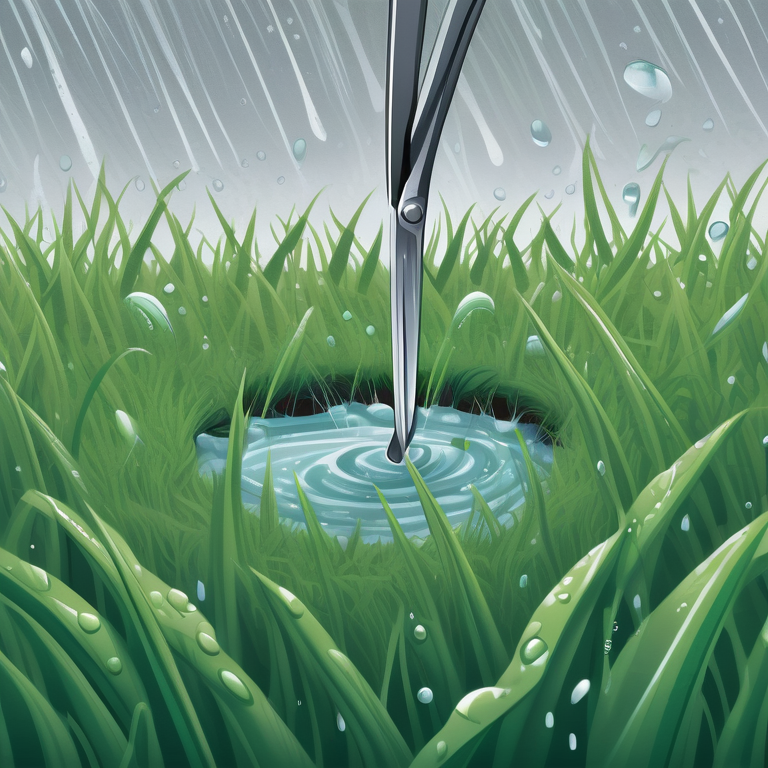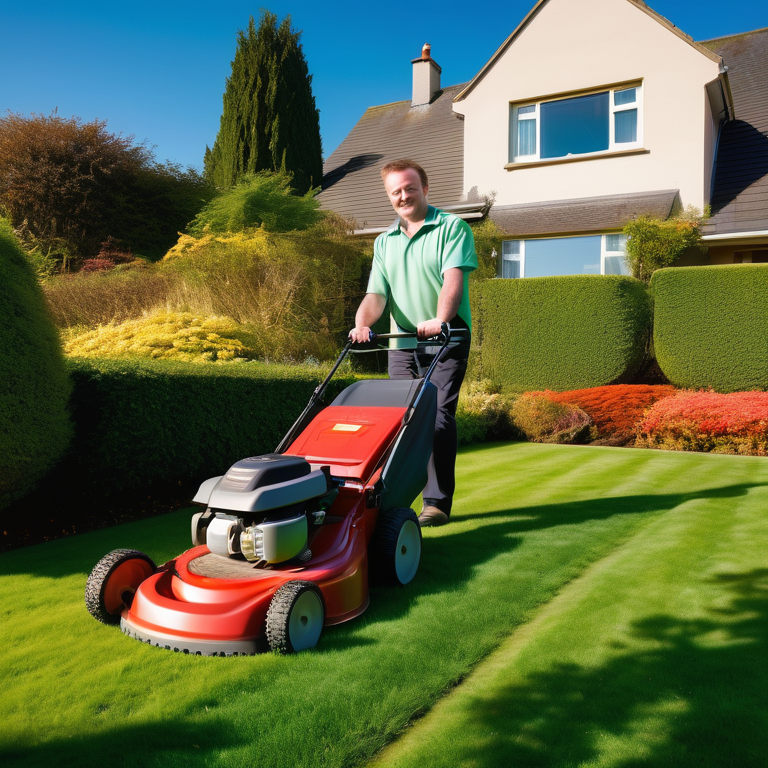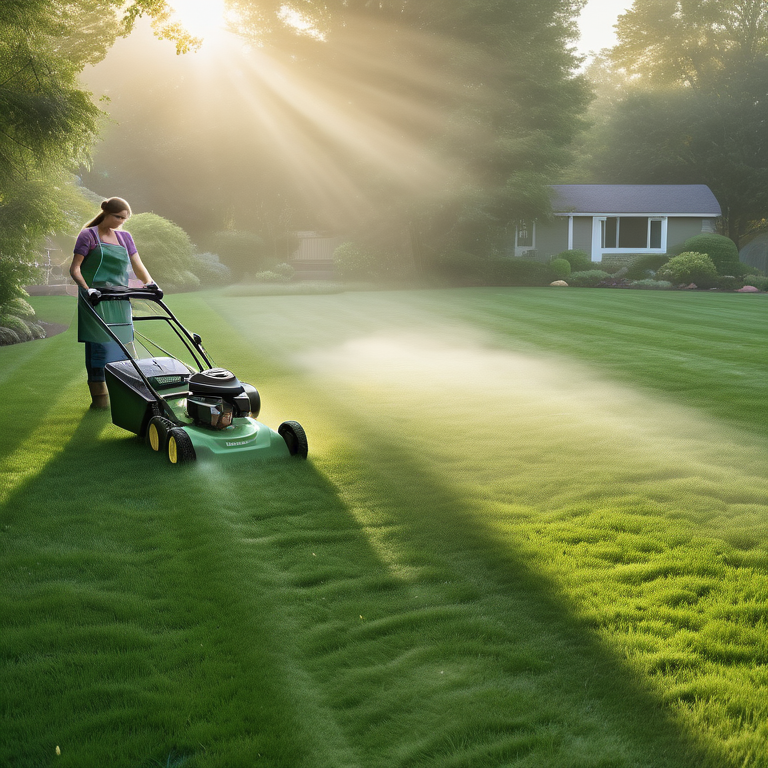What are the potential consequences of cutting wet grass?
Cutting wet grass can lead to an uneven cut, clumping of grass cuttings that can smother the lawn, increased risk of slipping accidents due to wet grass, and it can also spread lawn diseases more easily. It is advisable to wait until the grass is dry to ensure a clean cut.
What are the potential consequences of cutting wet grass?
Cutting wet grass can lead to a variety of consequences, including an uneven cut, grass clumping, damage to the lawn mower, increased risk of accidents due to slipping, and potential lawn diseases spread. It is generally advised to wait for grass to dry to ensure a clean and healthy cut.
Key Highlights
- Cutting wet grass can be dangerous for both the operator and the lawn mower due to the risk of electric shock and damage to the.
- Wet grass clippings can stick to the lawn mower, causing blockages and making the job more difficult.
- Cutting grass can result in an uneven cut and clumps of grass that can suffocate the lawn.
- Wet grass blades are slick and tough to slice, leading to a raggedy and uneven appearance.
- Mowing wet grass can spread fungal diseases and damage the soil, hindering the growth of healthy grass.
Introduction
Cutting the grass is a regular part of lawn care, but what happens when the grass is wet? Many homeowners find themselves in a dilemma when it comes to mowing wet grass. On one hand, the grass is growing, and it needs to be maintained. On the other hand, cutting wet grass, also known as mowing a wet lawn, can have negative consequences for both the operator and the lawn itself. In this ultimate guide, we will explore the risks and dangers of cutting wet grass, as well as the safety concerns and best practices for mowing under wet conditions.
Understanding the Risks of Cutting Wet Grass
Cutting wet grass can pose several risks to both the health of the lawn and the safety of the operator. Wet grass is more susceptible to lawn diseases and fungal infections, which can spread and cause damage to the entire lawn. Additionally, the weight of the lawn mower on wet soil can lead to soil compaction and the formation of ruts, which can hinder the growth of healthy grass in the future. Cutting dry grass is a better option as it reduces the risk of soil compaction and allows for a better cut. It is important to understand these risks before deciding to mow wet grass.
The Dangers to Your Lawn’s Health
When you cut wet grass, you not only put your lawn at risk of diseases but can also damage the grass blades. Wet grass clippings can stick to the underside of the mower deck, creating a breeding ground for mold and fungus. These clippings can then be spread to the rest of the lawn, leading to the development of lawn diseases and fungal infections. Additionally, the weight of the mower on wet soil can compact the soil and damage the roots of the grass, hindering its growth and overall health. It is important to consider these dangers before mowing wet grass. www.wicklowlandscaping.ie
Safety Concerns with Wet Grass Cutting
One of the main safety concerns when cutting wet grass is the risk of electric shock when using an electric lawn mower. The combination of water and electricity can be dangerous, especially with an extension cord. Wet conditions can also create a slippery surface, increasing the risk of accidents and falls. The operator could slip and fall too close to the lawn mower blades, leading to serious injuries. Wet grass can also impair visibility, making it difficult to see obstacles or the direction of mowing. It is important to take these safety concerns into account and take appropriate precautions when cutting wet grass, such as waiting for the grass to dry before mowing and regularly checking and maintaining the cutting blades of the lawn mower.
Key Takeaways on Cutting Wet Grass
When it comes to cutting wet grass, there are several key takeaways to keep in mind. Cutting wet grass can be dangerous for both the operator and the lawn mower, as it can lead to the risk of electric shock and damage to the machine. Wet grass clippings can stick to the lawn mower, causing blockages and making the job more difficult. Using a strimmer, also known as a trimmer, on wet grass can also lead to similar issues such as clogging and uneven cutting. It is best to wait for the lawn to dry out before using a strimmer for a cleaner and more effective cutting experience. It is important to take these factors into consideration and follow best practices for cutting grass.
What is Known and Unknown About Cutting Wet Grass
While there is some information available about cutting wet grass, there is still much that remains unknown. The effects of cutting wet grass on the health of the lawn and the safety of the operator are well-documented. However, the specific impact of wet weather conditions, such as morning dew, on the cutting process is still not fully understood. It is important to gather as much information as possible and make informed decisions when it comes to cutting wet grass. Taking into account factors such as the weather and the condition of the grass can help determine the best course of action. www.wicklowlandscaping.ie
Main Arguments Against Cutting Wet Grass
There are several main arguments against cutting wet grass. These include:
- Wet grass can result in an uneven cut, leading to a messy and unattractive lawn.
- Wet grass clippings can stick to the lawn mower, causing blockages and making the job more difficult.
- Cutting wet grass can result in grass stains on the operator’s clothes, shoes, and driveway.
- Wet grass can put extra strain on the lawn mower, potentially causing damage to the machine.
- Cutting wet grass can spread fungal diseases and damage the health of the lawn.
These arguments highlight the potential risks and negative consequences of cutting wet grass.
Preparing to Mow Wet Grass Safely
Before mowing wet grass, it is important to take the necessary precautions to ensure safety and minimize damage to the lawn mower and the grass itself. This includes preparing the lawn mower for wet conditions, such as ensuring that the mower deck is clean and free of debris. It is also important to clear the lawn of any obstacles or hazards that could pose a risk to the operator or the lawnmower. Taking these steps before mowing wet grass can help ensure a safe and effective mowing experience. www.wicklowlandscaping.ie
Essential Tools and Gear for Wet Conditions
When mowing wet grass, it is important to have the right tools and gear to ensure safety and effectiveness. This includes using a lawn mower that is suitable for wet conditions, such as one with a high-powered engine and good traction. It is also important to wear appropriate gear, such as waterproof shoes, to keep feet dry and prevent slipping. Other essential tools for mowing wet grass include a rake to clear wet clippings and a broom to sweep away excess water. By having the right tools and gear, including wet shoes, you can mow wet grass safely and efficiently.
Adjusting Your Mower for Wet Grass
When mowing wet grass, it is important to make adjustments to your lawn mower to ensure a clean and effective cut. This includes setting the mower deck to a high setting of 3 or 4 inches to prevent scalping the wet grass. It is also important to ensure that the mower blades are sharp and in good condition. Dull blades can tear the wet grass instead of cutting it cleanly. Additionally, it may be necessary to make multiple passes over the same area to achieve the desired cut. By adjusting your mower for wet grass, you can ensure a cleaner and more even cut. www.wicklowlandscaping.ie
Best Practices for Cutting Wet Grass
To achieve the best results when cutting wet grass, it is important to follow some best practices. One of the key factors to consider is the best time to mow wet grass. Mowing wet grass is best done during the late morning or early afternoon when the grass has had a chance to dry out slightly. This helps to reduce the risk of clumping and blockages in the mower deck. It is also important to regularly clean the mower deck to prevent the accumulation of wet grass clippings. By following these best practices, you can achieve a cleaner and more effective cut when mowing wet grass. www.wicklowlandscaping.ie
Techniques to Minimize Damage
When mowing wet grass, there are several techniques that can help minimize damage to the grass and the lawn mower. One technique is to raise the mower deck to a higher setting to prevent the blades from digging into the wet soil. This helps to reduce compaction and the formation of ruts. Another helpful technique is to use a lawn mower with a roller, which can add stripes to your lawn without causing excessive damage. It is also important to regularly clean the mower deck to prevent the accumulation of wet grass clippings, which can lead to blockages and hinder the mower’s performance. By using these techniques, you can minimize damage and ensure a healthier lawn.
When and How to Cut Wet Grass Without Harm
While it is generally recommended to avoid cutting wet grass, there are some situations where it may be necessary or more feasible. If you must cut wet grass, it is important to choose the best time of day to do so. The late morning or late afternoon is often the best time, as the grass has had a chance to dry out slightly. It is also important to ensure that the mower blade is sharp and in good condition to achieve a clean and even cut. By following these guidelines, you can minimize harm to the grass and achieve satisfactory results when cutting wet grass. www.wicklowlandscaping.ie
Alternatives to Cutting Wet Grass
In situations where cutting wet grass is not feasible or recommended, there are alternatives that can help maintain the appearance and health of your lawn. One alternative is to focus on lawn care practices that can help promote healthy growth and prevent the need for frequent mowing. This includes regular watering, proper fertilization, adequate aeration, and using mulch as a natural material to spread over garden soil to keep it healthy. Additionally, during periods of heavy rain or wet conditions, it may be necessary to wait for the grass to dry before proceeding with any maintenance activities. By exploring these alternatives, you can ensure the long-term health and beauty of your lawn. www.wicklowlandscaping.ie
Maintaining Your Lawn in Wet Conditions
Maintaining a lawn in wet conditions requires special attention and care. Wet weather and excessive moisture can create favorable conditions for lawn diseases and fungal infections. To prevent these issues, it is important to implement proper lawn care practices, such as regular mowing at the appropriate height, proper watering, and adequate aeration. It is also important to monitor the moisture levels in the soil and adjust watering accordingly. By maintaining your lawn in wet conditions, you can ensure its health and vitality.
When to Wait for Dryer Conditions
In some cases, it may be necessary to wait for dryer conditions before mowing the grass. This is especially true if the grass is excessively wet or if there are visible puddles in the lawn. Mowing wet grass under these conditions can lead to uneven cutting and damage to the lawn. Additionally, it is often a good idea to wait until the morning dew has evaporated before cutting the grass. Wet grass blades, also known as cut grass, can be tough to mow and can result in an uneven and messy appearance. By waiting for dryer conditions, you can ensure a cleaner and more effective cut. www.wicklowlandscaping.ie
The Role of Professional Landscaping
Professional landscaping services can play a crucial role in maintaining a healthy lawn, especially in wet conditions. Professional lawn care providers have the expertise and equipment to effectively mow and maintain wet grass. They often use commercial mowers that are specifically designed for wet conditions, minimizing damage to the grass and the soil. Additionally, professional landscapers can provide additional services such as aeration, fertilization, and pest control, ensuring the overall health and appearance of the lawn. Hiring a professional landscaping service can be a valuable investment in maintaining a beautiful and healthy lawn.
How www.wicklowlandscaping.ie Can Help
At www.wicklowlandscaping.ie, we specialize in professional lawn care services, including mowing and maintenance in wet conditions. Our team of skilled landscapers is equipped with commercial mowers specifically designed for wet grass, ensuring a clean and effective cut. We offer a range of services to cater to your lawn care needs, including aeration, fertilization, and pest control. With our expertise and experience, we can help you maintain a healthy and beautiful lawn, even in wet conditions. Contact us today for a consultation and let us take care of your lawn care needs. www.wicklowlandscaping.ie
Benefits of Professional Lawn Care in Wet Conditions
Professional lawn care in wet conditions offers several benefits. Firstly, professional landscapers have the knowledge and expertise to effectively maintain wet grass, minimizing the risk of damage to the lawn and ensuring a clean and even cut. They are also equipped with specialized commercial mowers that are designed to handle wet grass, allowing for more efficient and effective mowing. Additionally, professional lawn care providers can help prevent and treat lawn diseases and fungus that are common in wet conditions. By investing in professional lawn care, you can enjoy a healthy and beautiful lawn, regardless of the weather conditions. www.wicklowlandscaping.ie
Conclusion
In conclusion, cutting wet grass can have detrimental effects on both your lawn’s health and safety. It’s essential to understand the risks involved and take necessary precautions before mowing in wet conditions. By following best practices, such as using the right tools, adjusting your mower, and knowing when to wait for dryer conditions, you can minimize damage to your lawn. Consider professional landscaping services like www.wicklowlandscaping.ie for expert care in wet conditions. Remember, your lawn’s well-being depends on how you approach mowing in wet grass, so take the necessary steps to maintain a healthy and thriving outdoor space. www.wicklowlandscaping.ie
Frequently Asked Questions
Is It Ever Safe to Cut Wet Grass?
While it is generally recommended to avoid cutting wet grass, there are some situations where it may be safe to do so. If the grass is only slightly damp and there are no visible puddles or excessive moisture, it may be safe to mow wet grass. However, it is important to take precautions and follow best practices to minimize damage to the grass and the lawn mower.
How Can I Tell if the Grass is Too Wet to Cut?
Determining if the grass is too wet to cut can be done by assessing the moisture content of the grass and the soil. If the grass feels excessively wet to the touch and there are visible clumps or signs of standing water, it is best to wait for the grass to dry before mowing. Additionally, if the soil feels overly saturated and muddy, it is a good indication that the grass is too wet to cut.










